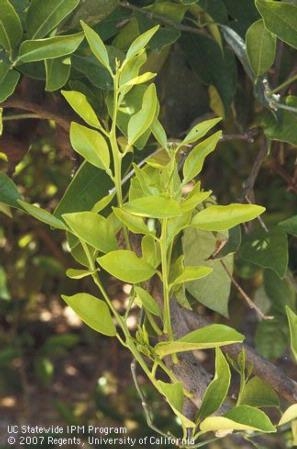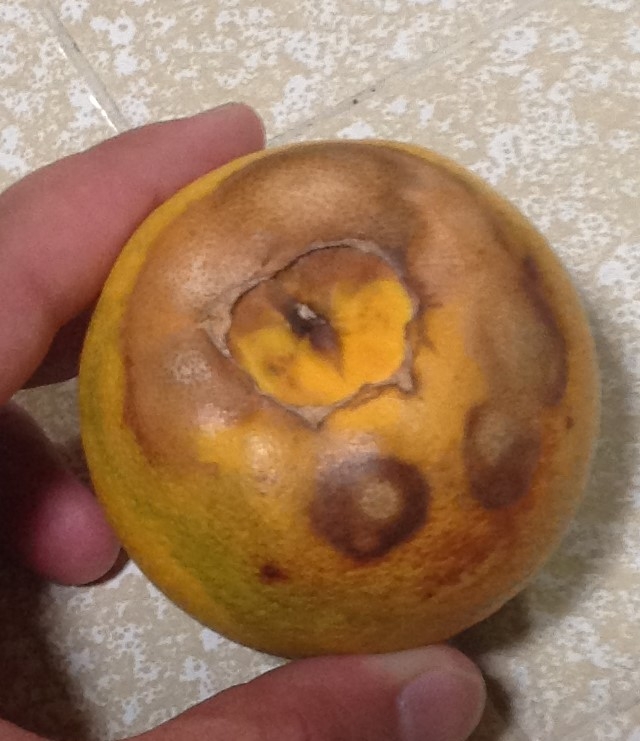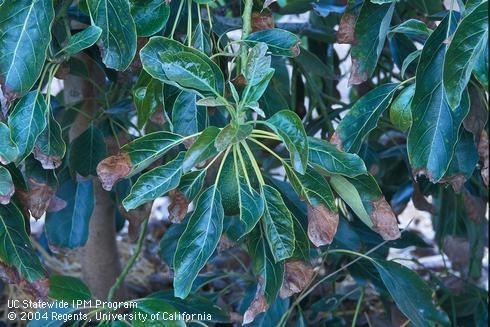
Posts Tagged: potassium
Drought Induced Problems in Our Orchards
Drought Induced Problems in Our Orchards
Abiotic disorders are plant problems that are non-infective. They are not caused by an organism, but through their damage, they may bring on damage caused by organisms. Think of a tree hit by lightning or a tractor. The damage breaches the protective bark which allows fungi to start working on the damaged area, eventually leading to a decayed trunk. It was the mechanical damage, though that set the process in motion.
Too much or too little water can also predispose a plant to disease. Think of Phytophthora root rot or even asphyxiation that can come from waterlogging or too frequent irrigations.
Salinity Effects from Lack of Water
Lack of water and especially sufficient rainfall can lead to salinity and specific salts like boron, sodium and chloride accumulating in the root zone. This happens from a lack of leaching that removes native soil salts from the root zone or the salts from the previous salt-laden irrigation from the root zone. These salts cause their own kind of damage, but they can also predispose a tree to disorders, disease and invertebrate (insect and mite) damage.
Lack of water and salt accumulation act in a similar fashion. Soil salt acts in competition with roots for water. The more soil salt, the harder a tree needs to pull on water to get what it needs. The first symptom of lack of water or salt accumulation may be an initial dropping of the leaves. If this condition is more persistent, though we start to see what is called “tip burn” or “salt damage”. Southern California is tremendously dependent on rainfall to clean up irrigation salts, and when rain is lacking, irrigation must be relied on to do the leaching
As the lack of leaching advances (lack of rainfall and sufficient irrigation leaching) the canopy thins from leaf drop, exposing fruit to sunburn and fruit shriveling.
Leaf drop and fruit shriveling in avocado.
In the case of sensitive citrus varieties like mandarins, water stress can lead to a pithy core with darker colored seeds, almost as if the fruit had matured too long on the tree.
Total salinity plays an important factor in plant disorder, but also the specific salts. These salts accumulate in the older leaves, and cause characteristic symptoms that are characteristic in most trees. Boron will appear on older leaves, causing an initial terminal yellowing in the leaf that gradually turns to a tip burn.
Often times it is hard to distinguish between chloride, sodium and total salinity damage. It is somewhat a moot point, since the method to control all of them is the same – increased leaching. There is no amendment or fertilizer that can be applied that will correct this problem. The damage symptoms do not go away until the leaf drops and a new one replaces it. By that time hopefully rain and/or a more efficient irrigation program has been put in place.
The Impact of Drought on Nutrient Deficiencies
Salinity and drought stress can also lead to mineral deficiencies. This is either due to the lack of water movement carrying nutrients or to direct completion for nutrients. A common deficiency for drought stressed plants is nitrogen deficiency from lack of water entraining that nutrient into the plant.
This usually starts out in the older tissue and gradually spreads to the younger tissue in more advanced cases.
The salts in the root zone can also lead to competition for uptake of other nutrients like calcium and potassium. Apples and tomatoes are famous for blossom end rot when calcium uptake is low, but we have also seen it in citrus. Low calcium in avocado, and many other fruits, leads to lower shelf life. Sodium and boron accumulation in the root zone can lead to induced calcium deficiencies and increased sodium can also further lead to potassium deficiencies. Leaching can help remove these competitive elements.
Drought Effect on Tree Disease
Drought and salt stress can also lead to disease, but in many cases once the problem has been dealt with the disease symptoms slowly disappear. They are secondary pathogens and unless it is a young tree (under three years of age) or one blighted with a more aggressive disease, the disease condition is not fatal. Often times, in the best of years, on hilly ground these diseases might be seen where water pressure is lowest or there are broken or clogged emitters. The symptoms are many – leaf blights, cankers, dieback, gummosis – but they are all caused by decomposing fungi that are found in the decaying material found in orchards, especially in the naturally occurring avocado mulch or artificially mulched orchards. Many of these fungi are related Botryosphaerias, but we once lumped then all under the fungus Dothiorella. These decay fungi will go to all manner of plant species, from citrus to roses to Brazilian pepper.
Another secondary pathogen that clears up as soon as the stress is relieved is bacterial canker in avocado. These ugly cankers form white crusted circles that ooze sap, but when the tree is healthy again, the cankers dry up with a little bark flap where the canker had been.
Drought Effect on Pests
Water/salt stress also makes trees more susceptible to insect and mite attack. Mites are often predated by predacious mites, and when there are dusty situations, they can't do their jobs efficiently and mites can get out of hand. Mite damage on leaves is often noted in well irrigated orchards along dusty picking rows
Many borers are attracted to water stressed trees and it is possible that the Polyphagous and Kuroshio Shot Hole Borers are more attracted to those trees.
And then we have conditions like Valencia rind stain that also appears in other citrus varieties. We know it will show up in water stressed trees, but we aren't sure what the mechanism that causes this rind breakdown just at color break. Could it be from thrips attracted to the stressed tree or a nutrient imbalance, it's not clear?
Water and salt stress can have all manner of effects on tree growth. It should lead to smaller trees, smaller crops and smaller fruit. The only way to manage this condition is through irrigation management. Using all the tools available, such as CIMIS, soil probes, soil sensors, your eyes, etc. and good quality available water are the way to improve management of the orchard to avoid these problems.
Scroll down for Images
Tip Burn, notice sun burn bottom right hand fruit
Endoxerosis with dried out core
Boron toxicity
Nitrogen deficiency
Blossom end rot
Potassium deficiency
Bot gumming in lemon
Black Streak in Avocado
Bacterial Canker
Citrus red mite
Polyphagous Shot Hole Borer damage on avocado
Valencia Rind Stain

avocado drought canopy

nitrogen deficiency

endoxerosis 4

boron toxicity citrus 1

blossom end rot lemon

potassium deficiency avocado

gumming dothiorella

avocado black streak 1

bacterial canker avocado

citrus red mite

PSHB damage
Salt, Sodium and Potassium and Drought
Potassium deficiency in avocado and citrus leaves often looks like salt stress and more specifically sodium toxicity. Plants will often look wilted with curled leaves, yellow areas between leaf veins and dead areas along the margins of the leaves. Salt stress refers to the excessive amount of soluble salts in the root zone which induce osmotic stress (appearance of lack of water) and ion toxicity (growing problems and often symptoms) in the growing plant. Among toxic ions, sodium (Na+) has the most adverse effects on plant growth by its detrimental influence on plant metabolism in inhibiting enzyme activities. An optimal potassium (K+) : Na+ ratio is vital to activate enzymatic reactions in the cytoplasm necessary for maintenance of plant growth and yield development These enzymes control such functions as the stomata which regulate water and photosynthesis control in the plant. Although most soils have adequate amounts of K+, uptake is exacerbated under sodic or saline-sodic soil conditions as a consequence of K+-Na+ antagonism. Here K+ uptake by plants is severely affected by the presence of Na+ in the soil. Due to its similar chemical properties, Na+ competes with K+ in plant uptake It would seem a reasonable assumption therefore that an increase in the concentration of K+ in salt-affected soils may support enhanced K+ uptake. And that has been noted in many plant species including citrus and avocado.
But aside from the role of potassium in drought tolerance there are many functions of potassium in plants:
• Increases root growth and improves drought resistance
• Activates many enzyme systems
• Maintains turgor; reduces water loss and wilting
• Aids in photosynthesis and food
• Reduces respiration, preventing energy losses
• Enhances translocation of sugars and starch
• Produces grain rich in starch
• Increases protein content of plants
• Builds cellulose
• Helps retard crop diseases
In the case of avocado and citrus there is about twice the amount of potassium as nitrogen harvested in the crop, yet many growers do not consider potassium in their normal practices, much less when drought has increased salt stress on the trees. The end of August through September is when leaf analysis is best used to adjust a fertilizer program.
Sodium toxicity and Potassium deficiency in avocado

avocado sodium toxicity

potassium deficiency avocado
Silicon as a Nutrient for California Fruit Trees
Silicon is currently under consideration for elevation to the status of a "plant beneficial substance by the Association of American Plant Food Control Officials (AAPFCO). Silicon has been shown in university and field studies to improve cell wall strength and structural integrity, improve drought and frost resistance, decrease lodging potential and boost the plant's natural pest and disease fighting systems. Silicon has also been shown to improve plant vigor and physiology by improving root mass and density, and increasing above ground plant biomass and crop yields.
Silicon (Si) is the most abundant element (27.2%) present in the earth's crust following oxygen (45.5%). Silicon is known for a number of important chemical and physical properties, i.e. semiconductor property that are used in various scientific and technical applications. In most soils near a neutral pH, the composition is a complex of iron, aluminum, oxygen and silicon. Silicon is one of the most important constituents of dust, which is carried by winds all over the world. Geologists know silicon as the rock quartz and the many silicate materials, such as opal. Formally, silica (SiO2) is a silicic acid (H4SiO4), which is water soluble and stable in highly dilute aqueous solutions. There are many forms that silicon can take in the natural environment, often complexed with water. Plants take up a form of silicic acid and in highly leached, low pH environments, much of the silicon may have been removed over time.
It appears that grains, such as wheat and especially rice have an absolute need of supplemental silicon to improve plant growth. Few non-grass plants have shown this need other than cucurbits apparently. Much of the improvement typically is for improved disease control and improved stature (prevention of lodging).
Many of the studies showing benefits of silicon amendment have occurred in low soil pH environments or in solution culture where it has been possible to create low silicon growing media. Several years ago, potassium silicate was being promoted as a fungistat for controlling Phytophthora root rot in avocado. A number of field and greenhouse trials were tried in California during the early 2000s to assay its effect. For whatever reason, the material showed no effect on the disease. Potassium and calcium silicates are liming materials, raising soil pH. The effect that was noticed in its use in other countries may simply have been a soil pH effect on either the avocado tree, the Phytophthora or both.

silicon
Putting Fertilizer Chloride in Perspective
Especially when there are no winter rains to leach accumulated salts from the root zone of trees, there is major concern about increasing the levels of salts going into the root zone. Chlorides, boron, sodium and total salts all should be minimized as much as possible in order to optimize tree production and health. Evaluating the fertilizer and irrigation management programs is important and in doing so, finding out how much is being put into the orchard.
A wonderful way to evaluate what is being applied through the irrigation system is to go online to AvocadoSource (avocadosource.com) and go to the ‘Tools' section and click on the ‘Irrigation Water Mineral Content Calculator'. Once there click on ‘Retrieve District Water Analysis Data' and there are several water qualities that can be downloaded onto the calculator.
I chose one of the Metropolitan Water District sources – Castaic Lake – which is representative of water delivered to the south from northern California. It shows a chloride level of 81 mg/L (81 ppm) which translates to 220 pounds of chloride for every acre-foot of water. Which means about 440 pounds of chloride per acre (about 2 ac-ft/ac) to grow avocado and citrus in Fillmore. And the same water coming out of Lake Skinner further south but nearly the same quality as Castaic, would be 880 pounds of chloride per acre in Fallbrook (4 ac-ft/ac).
So the question comes up about the use of potassium fertilizers. Citrus and avocado haul off about twice the potassium in their fruit as nitrogen. A typical harvest for either crop is about 50 pounds of K per acre – more fruit, more K. So to apply potassium, a grower can use several different materials – KMag, potassium thiosulfate, potassium sulfate, potassium nitrate, potassium chloride. A 100 pounds of either potassium sulfate or chloride put on about the same amount of potassium, 50 pounds. With the potassium chloride or course, there is 50 pounds of chloride.
The cheapest source of K is potassium chloride, but growers are concerned about the added chloride. The material is highly soluble and is easily injectable. It also is rapidly moved through the soil, so when it is injected through the irrigation in small amounts, the chloride tends not to accumulate in the root zone. So looking at the total amount of chloride that is applied in our normal irrigation waters, the chloride in the fertilizer doesn't represent a large proportion of the total chloride the tree sees. It could be considered in a fertilizer program, or at least a supplement to other sources of potassium.
Potassium is relatively immobile in soil, more so with more clay. Chloride on the other hand is quite mobile. It goes wherever the water goes. Applying it any time of the year basically results in its staying there until it is taken up or the soil is washed away. So applying potassium chloride in a wetter time of year, could be a cheap way to get potassium on with the least effect of chloride. Or potassium chloride could be applied in rotation with more expensive forms of potassium, such as potassium thiosulfate (KTS).
By the way, that Castaic water would contain 87 ppm sulfate and 74 ppm sodium which would mean over 200 pounds per ac-ft in the water and 110 ppm bicarbonates. The pH would be around 7.8. And this is good water by southern California standards. Many of the well water in southern California have much lower qualities than these waters from norther California and we get good yields from them. We have learned to use some pretty awful waters to grow crops here.

chloride toxicity avocado
Nitrogen and Potassium Uptake of Avocado Fruit
At a recent avocado meeting, Carol Lovatt of the Botany Department at UC Riverside pointed out that avocado fruit take up more potassium than nitrogen, almost twice as much, and that much of that uptake occurs later when the fruit is expanding. She reminds growers that all to often, the potassium needs of the tree are overlooked.
Click on "attached files, potassium nitrogen uptake" to view graphs.
potassium nitrogen uptake
